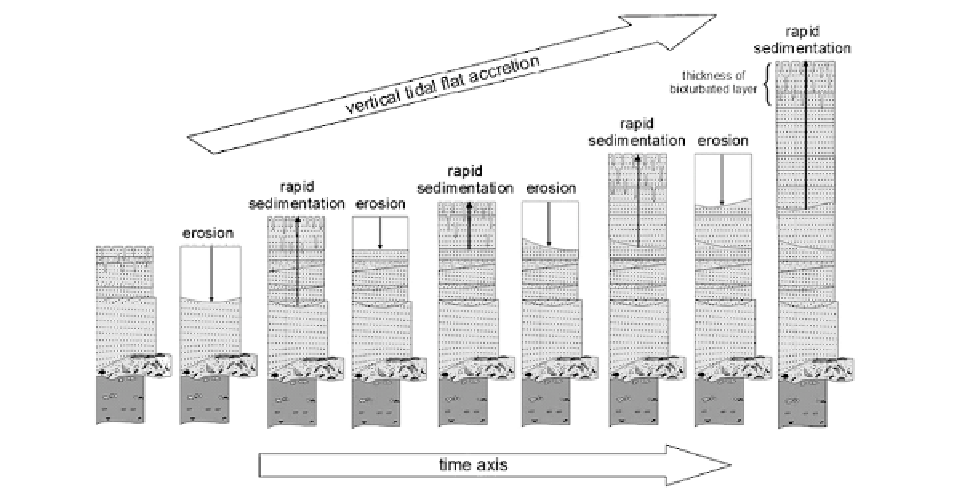Geology Reference
In-Depth Information
Fig. 10.27
Conceptual model illustrating the situation where physical reworking of the sediment outpaces bioturbation in the
course of vertical accretion as observed in many parts of the Wadden Sea (Modified after Chang et al.
2006c
)
sequence having simply been removed by migrating
channels. Tidal-flat deposition above the channel
sequence commences at higher energy conditions than
required for the formation and preservation of lenticu-
lar, wavy and flaser bedding. The core demonstrates
that, in the course of transgression, local conditions on
a tidal flat can vary strongly, frequent depositional and
erosional events ultimately resulting in only partial
preservation of the potential record (Reineck
1960
;
van der Spek
1996
). This not only concerns the preser-
vation of particular sedimentary sequences as illus-
trated in the idealized model, but also the preservation
of biological activity as suggested by the general
absence of bioturbation throughout the core, except for
the uppermost active layer. Within certain limits, the
degree of preserved bioturbation is evidently an excel-
lent criterion for the depth of reworking of a tidal flat
by waves and/or currents. Because physical reworking
of intertidal flats is generally restricted to the depth of
intertidal creeks (~50 cm), this concept can only be
applied to regions where the bioturbated layer is rela-
tively thin (20-30 cm). This is generally the case in
temperate climates. In subtropical and tropical climates,
by contrast, callianassid shrimps will completely
bioturbate the sediment to depths exceeding 1 m and
hence obliterate the effects of physical reworking.
Identification of the type of bioturbating organism(s)
is thus a crucial prerequisite for the application of this
concept to the rock record (Dott
1983, 1988
).
For the temperate Wadden Sea, van Straaten (
1954
)
presented a conceptual model that considers a number
of different situations ranging from complete bioturba-
tion to almost no bioturbation. The model was later
modified slightly by Reineck and Singh (
1980
). As
remarked earlier, only the uppermost 15 cm of the core
in Fig.
10.26
, i.e. the biologically active layer at the time
of coring, is preserved. This means that the frequency
and depth of reworking at the coring site has consis-
tently outpaced bioturbation from the very start and
thereby documents the rather exposed nature of the
Wadden Sea (cf. Davis and Flemming
1995
). This situ-
ation is illustrated in the conceptual model of Fig.
10.27
(after Chang et al.
2006c
; cf. also van der Spek
1996
).
As shown above, the succession of depositional
facies along the intertidal gradient and their character-
istic sedimentary structures will produce typical and
easily recognized stratigraphic sequences in the course
of vertical accretion. The main driving forces on geo-
logical time scales are changes in relative sea level and
sediment supply, both being primarily controlled by

